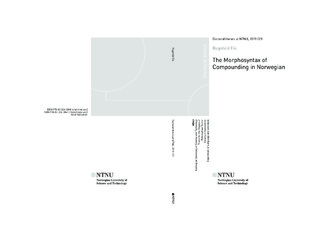| dc.contributor.advisor | Lohndal, Terje | |
| dc.contributor.advisor | Åfarli, Tor Anders | |
| dc.contributor.author | Eik, Ragnhild | |
| dc.date.accessioned | 2019-09-17T07:22:50Z | |
| dc.date.available | 2019-09-17T07:22:50Z | |
| dc.date.issued | 2019 | |
| dc.identifier.isbn | 978-82-326-3841-3 | |
| dc.identifier.issn | 1503-8181 | |
| dc.identifier.uri | http://hdl.handle.net/11250/2617105 | |
| dc.description.abstract | Sammendrag
Samansetjing er namnet på den grammatiske prosessen der to eller fleire ord blir sette saman for å danne nye, meir komplekse ord med meir komplekse tydingar. Tekopp og tekoppselgar er to døme på ord som er danna gjennom samansetjing. I tillegg til å vere ein svært grunnleggjande grammatisk prosess er samansetjing eit tydeleg uttrykk for den kreative evna vi menneske har til å namngi og utvikle nye konsept etter kvart som verda endrar seg. For å forstå nøyaktig korleis denne prosessen fungerer, er det nødvendig å studere samansetjing i mange ulike språk. Forskinga mi bidrar til dette ved å beskrive og analysere samansetjing i norsk.
Norsk er eit av språka i verda der samansetjing er aller vanlegast og eignar seg derfor spesielt godt til å undersøke denne delen av den kreative språkevna. Ved å analysere dei grunnleggjande byggeklossane i norske samansette ord og måten dei er sette saman på, utviklar eg ein modell som kan forutseie kva typar samansetjingar som er moglege å danne på norsk og kva typar samansetjingar som ikkje er moglege. Modellen gir også prediksjonar for kva slags variasjon vi kan forvente oss å finne i andre språk, og legg slik eit grunnlag for framtidig tverrspråkleg samanlikning. Slik bidrar denne forskinga på ei side til å forstå ein sentral del av norsk grammatikk, og på ei anna side til å skaffe nye innsikter i språkleg kreativitet. | nb_NO |
| dc.description.abstract | Summary
Compounding is the grammatical process whereby two or more words are combined to form new, more complex words with more complex meanings. Teacup and teacup seller are two examples of words created by compounding. The process of compounding is a clear example of the human ability to create and refine concepts in response to a constantly changing world. To understand how this process works it is necessary to study and compare compounding in many different languages. My research contributes to this goal by describing and analyzing compounding in Norwegian.
Norwegian is a language where compounding is very common and is therefore likely to provide valuable insights into the underlying mechanics of the phenomenon. By analyzing the basic building blocks of Norwegian compounds and the way they are combined, I develop a model that can predict what types of compounds can be formed in Norwegian, and what types of compounds are not possible. The model also allows us to predict what type of variation we might expect to find across languages, thus laying the groundwork for future cross-linguistic comparisons. Thus, the research contributes to the understanding of a crucial part of Norwegian grammar on the one hand, and to a deeper understanding of general human linguistic abilities on the other. | nb_NO |
| dc.language.iso | eng | nb_NO |
| dc.publisher | NTNU | nb_NO |
| dc.relation.ispartofseries | Doctoral theses at NTNU;2019:121 | |
| dc.title | The Morphosyntax of Compounding in Norwegian | nb_NO |
| dc.type | Doctoral thesis | nb_NO |
| dc.subject.nsi | VDP::Humanities: 000::Linguistics: 010 | nb_NO |
